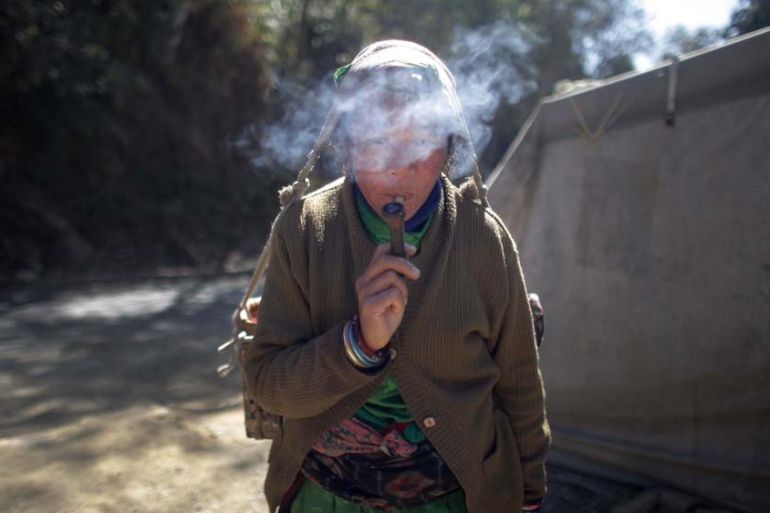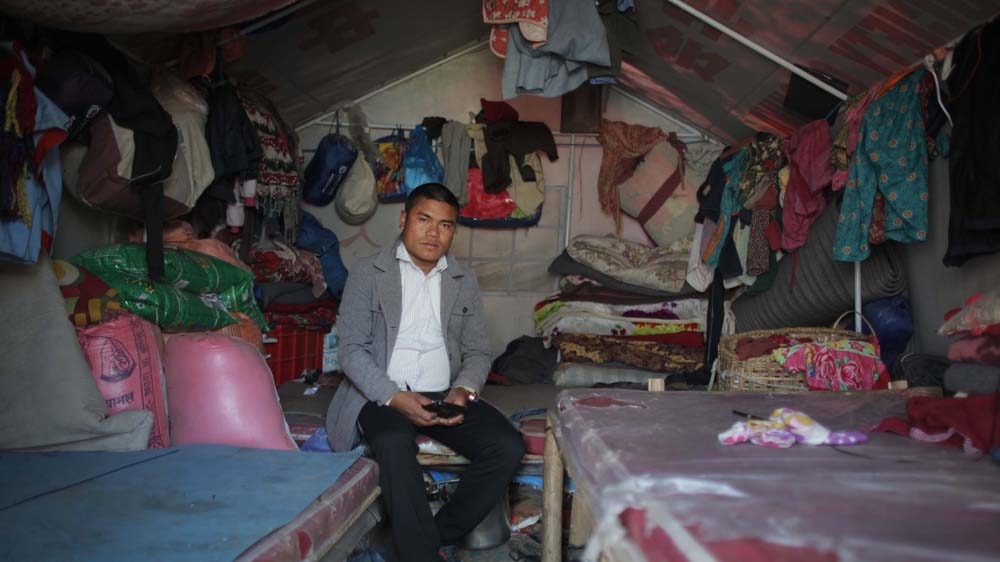In Nepal, a community rising from the rubble
The residents of Tiru lost everything in the quake but, determined to stay together, they are building a new community.

Rather than wait for the government of Nepal to come to its rescue, a settlement of 90 families displaced by the April 25, 2015, earthquake is determined to resettle by its own efforts.
Before the quake, life in the village of Tiru, in Haku village development committee of the Rasuwa district, was one of pastoral toil and subsistence farming, but it was stable and predictable.
Keep reading
list of 4 items‘Mama we’re dying’: Only able to hear her kids in Gaza in their final days
Europe pledges to boost aid to Sudan on unwelcome war anniversary
Birth, death, escape: Three women’s struggle through Sudan’s war
The settlement was densely grouped along a narrow ledge between steep mountain and precipice, with paths cutting across cliffs on two sides.
Tiru is about 54km from Kathmandu as the crow flies, but it takes nearly three days to reach by road and foot.
Above the village of rough-hewn stone houses were pastures where villagers grazed their sheep and goats, and below were fields for maize and millet, potatoes and vegetables.
![The community has grown tired of waiting for help from the government and is now determined to resettle by its own efforts [Niranjan Shrestha/Al Jazeera]](/wp-content/uploads/2016/03/52f5555468c54fdaa15688b3aa42b6f9_18.jpeg)
When the earth trembled
“I had heard that the earth would tremble before being destroyed. That is how it felt,” she says.
The landslides destroyed all access to Tiru, trapping the survivors on a narrow ledge amid the detritus of what had been their way of life.
Without the necessary resources to restore the paths or even attend to funerary duties, the people of Tiru left with whatever possessions they could carry. Cattle that hadn’t been killed by the quakes were abandoned to the surrounding jungles.
They walked for two days to reach Archale, the nearest village with usable roads, and joined thousands of other displaced families.
![Separated from their agrarian routine, Tiru villagers living at the Kalikasthan IDP camp keep themselves occupied. Bamboo is among the few resources the local community allows Tiru villagers to use [Niranjan Shrestha/Al Jazeera]](/wp-content/uploads/2016/03/12896d4d2b694b7a8fb709b16534eb94_18.jpeg)
Staying together
After being scattered across different camps, the people of Tiru regrouped at the village of Kalikasthan, 15km south of Tiru.
Bom Bahadur, a community leader from Tiru and a former rebel affiliated with the Maoists, realised that most of the emergency assistance provided by the state would be spent in trying to procure the paperwork necessary to prove eligibility for subsidised rebuilding loans.
Eager to keep the community intact through the crisis, he brought together his friends, Buddhi Bahadur, 31, and Bal Bodh, 34, and proposed a resettlement plan that would do just that. The Haku Earthquake Victims Struggle Committee was created to execute the vision.
“We collected every single rupee that came to us from the government, and from other donors. We opened a bank account and shared the account number with everybody. People made deposits at the bank and submitted the vouchers to the committee,” explains Bal Bodh.
Each of the 90 households contributed at least $450 from the monetary assistance they received from the government and a few private sources towards the land-purchase fund, along with cash earned from selling all of their valuables. Bal Bodh and Buddhi Bahadur personally secured additional loans at the exorbitant rate of 25 percent per annum.
Two adjacent plots of land were bought in Battar, a sweltering red table of land overlooking the Trishuli River, at a cost of nearly $185,000.
Manju liked the new land, even though it is a two-day journey from Tiru. “It is in a good place. There is no risk of landslides,” she says. There is a spring within the property, and a pocket of ethnic Tamangs around the proposed settlement.
 |
| Bom Bahadur, 34, in his tent. He convinced the 90 displaced families from Tiru village to collectively purchase land on which to resettle [Niranjan Shrestha/Al Jazeera] |
A community in exile
But, uprooting an entire community does not come without a price.
“Nuwakot is a different country, with a different language. We have to think of it as exile,” says Bom Bahadur.
Although each family will receive property deeds to their plot of land, it won’t be much of a plot: at about 63 sq metres there will be enough space to build two small rooms and a bathroom. Some households have two or three members, but most have five or more.
Will the division of land prove problematic?
“No,” says Bal Bodh. “In Tiru we lived in just as cramped a settlement, with each house abutting another, in long rows. We won’t fight among ourselves. We have left behind our homes and our village. It is no use getting into fights here.”
“In our village we helped each other in illness and death. That is why we have decided to continue living as a single community,” adds Bom Bahadur. “Wherever we go, we will do everything to preserve our culture. We will set aside space for a community centre or a monastery.”
![The land selected for the new settlement has good access to healthcare and education, and the risk of landslides is non-existent [Niranjan Shrestha/Al Jazeera]](/wp-content/uploads/2016/03/49c824e247534beda4c0c2c014735c7c_18.jpeg)
The courage to build a new life
There is hope for the future, but also apprehension.
The new land has water, schools and excellent access to healthcare services. But, there is no money with which to start building the new settlement.
“We don’t have any more money to build with. If we receive assistance from charitable organisations, we can start rebuilding,” says Bal Bodh, before adding: “Or, we’ll have to sell ourselves. What else do we have left now?”
There is resentment towards the local bureaucracy for the many hurdles it has put before the earthquake survivors as they attempt to claim basic services.
Of particular contention is the matter of the $400,000 in relief that was collected from Korea, to benefit those who had been directly affected by, or were involved in, the 216 megawatt Trishuli-I hydropower facility being built by a Korean company. But the former residents of Tiru say that they received no more than one 30kg sack of rice and two bundles of corrugated iron sheets for each household, worth approximately $120 in value.
“We had wanted the money to go towards buying land to resettle the village. We would have added our funds towards building our houses,” explains Bom Bahadur. But, according to a public notice by the chief district officer, the fund has already been spent on providing relief materials and services.
“We don’t want donations of money. If somebody would give us building materials we would do the work ourselves. We would build each other’s houses and resettle the community,” says Bom Bahadur. “We will employ our brains and our conscience. We’ll raise poultry and we’ll grow vegetables. But the courage to make a new life will be possible only when we have homes.”
“If we could learn new skills and if we could build our homes here, we could face the future,” says Manju.
“It used to snow in Tiru. The air was clean. Here, the air is polluted. Cooking fuel is scarce. Villagers in Kalikasthan don’t like us gathering firewood from their forest. But, the earthquake destroyed our house, and the landslide took all of our fields. We have nothing to return to. If we don’t resettle and live together, where else will we turn to?”
![Babies born at the Kalikasthan temporary camp will grow up in surroundings vastly different from their ancestral village of Tiru [Niranjan Shrestha/Al Jazeera]](/wp-content/uploads/2016/03/9ebd3b76a70e46b19313f37c6daf8889_18.jpeg)